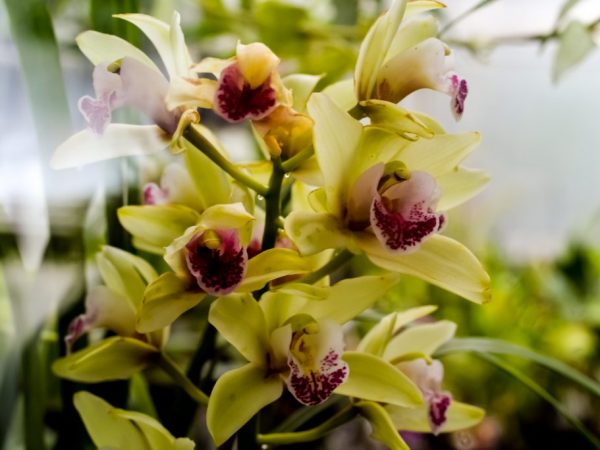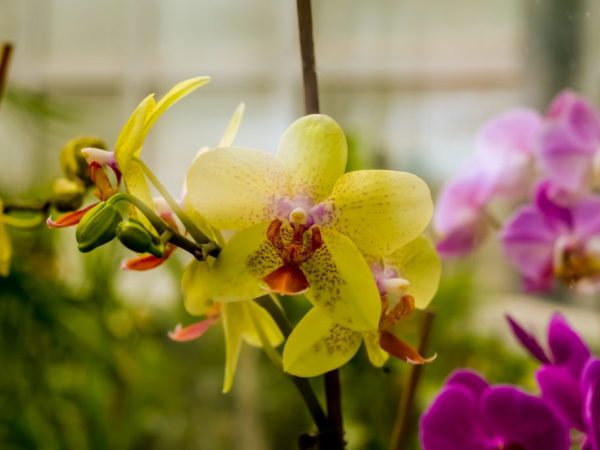How to reproduce an orchid with a peduncle
The orchid has become a resident of many houses. She is unpretentious in care and looks unusual. With minimal effort, the overseas beauty easily adapts to the microclimate of the apartment. Its flowers are pleasing to the eye for up to 10 months a year. For some growers, one stem is not enough, so they practice the propagation of an orchid with a peduncle.

How to reproduce an orchid with a peduncle
General recommendations
The peduncle is the rudiment of a new plant that forms in the leaf axil. It is often confused with the root, especially in the early stages of development. The desired part has an uneven, slightly pointed shape. The root, in contrast to the peduncle, is always smooth, semicircular in shape.
To get a strong and sturdy plant, adhere to the following recommendations:
- Healthy plants are chosen for the propagation of orchids with peduncles. Patients have black or yellowish leaves covered with mucus.
- The lower dormant bud is left on the peduncle.
- Places of cuts on the inflorescence and the plant itself are treated with an antibacterial composition. Then it is sprinkled with activated charcoal or charcoal powder.
Breeding exotic liana is best done when it fades. So the resources of the flower will be used for reproduction.
Peduncle cuttings
One of the common methods of divorcing an orchid at home is cuttings. The essence of the method consists in dividing the stem into parts. The optimal time for this is the last months of spring and early summer. After flowering, the stalk is cut off at the very base and divided into several parts. All pruning instruments must be sterile. The length of each cut is 3-4 cm. A dormant bud should be placed in the center of the cutting.
The prepared pieces are placed in a mini-greenhouse with moistened moss or sand. The latter is made of dense polyethylene, aquariums, plastic disposable containers. It is convenient to plant twigs in zip bags.
The most important thing in the cultivation of orchids with cuttings of a peduncle is further care. As it dries, the moss is sprayed with a spray bottle. The ideal humidity is 50-80%. Strictly maintain the temperature regime within 28 ° C-30 ° C. Every day the greenhouses are ventilated for 2 hours. They also do insolation for 14 hours daily. With insufficient illumination of the room, a phytolamp is installed.
Cuttings can be kept in greenhouses until 2-3 roots are formed. When they reach a length of 3-5 cm, the flowers will be able to feed themselves on their own. This happens about 2-3 weeks after planting.
Growing a peduncle in water

The scion is in the water
Orchid reproduction at home is carried out by cutting off the inflorescence. This method of propagating with a peduncle is applicable when the mother plant is sick. It is placed in a plastic bottle without a neck. The container is filled with filtered water. It should cover the peduncle by 4–5 cm.
For a disinfecting effect, an activated carbon tablet and concentrated mineral fertilizer are added.The method of administration and doses are usually indicated on the package.
All this time, the water in the bottle is changed at least once a week. The air temperature is maintained within the range of 25 ° C-28 ° C. If this condition is not met, a stalk will grow from the bud, not a baby.
Stimulating the growth of children
To stimulate the development of dormant buds of the peduncle for reproduction, the scales covering them are removed. Bare areas are treated with hormonal paste every week for a month. The process of awakening the kidney will be accelerated by spraying with Doctor Folly.
Another method has proven itself well: sleeping buds are wrapped in wet moss and cellophane. The orchid is kept in a warm room. As soon as young shoots are formed, the polyethylene is removed. The sphagnum is left until the roots appear.
A remedy for stimulating the growth of children is prepared at home. To do this, dissolve 10 mg of the drug "6-BAP" (6-benzaminopurine) or "Kinetin" in 1 ml of water. Optionally add 1 g of lanolin. All components are thoroughly mixed until a homogeneous mass is obtained. The white mixture is applied in a thin layer to the plant.
A single treatment of the buds and an air temperature of 20 ° C-22 ° C provokes the formation of a lateral branch of the peduncle. To prevent this, the flower is sent to an insulator with an air temperature of at least 28 ° C. After 3-5 days, the procedure is repeated. This is how vegetative shoots are obtained.
Department of babies
Soon, the children will release several leaves and form a root system of 5 or more shoots. Now they are separated: plants are able to develop independently.
It requires a scalpel or a sharp knife to work. The manipulation is carried out in the morning. The optimum room temperature is not lower than 25 ° С. Air humidity should normally be about 60%. A part of the peduncle is cut off with a sharp movement (1 cm lower or higher than the baby). The cut sites are treated with a disinfectant. They are allowed to dry out a little, and then they begin to disembark.
Small plastic cups or containers are suitable for children. The selected container is thoroughly washed with a saturated manganese solution. Several drainage holes are made on the bottom and side walls. This helps to wick away moisture.
The substrate is prepared in advance. For this, moss and bark are used. To destroy parasites and pathogenic bacteria, the raw materials are boiled for 20 minutes and then dried a little.
The planting of the cut baby is performed according to the following scheme:
- drainage from the bark of the middle fraction is laid on the bottom of the pot;
- sprinkle on top with a substrate consisting of moss and small pieces of bark;
- a plant is placed in the center of the container and the remaining soil is added.
For several days, the planted indoor culture is not watered. It is desirable that she be in a greenhouse that is constantly ventilated.
Possible problems
When breeding orchids at home, you have to face a number of difficulties. For example, with yellowing of the leaves of children. This is due to a lack of nutrients in the soil. The plant needs to be fed with fertilizers (by spraying).
It may be that babies do not appear on the peduncle at all. The reason for this is too comfortable conditions. The flower is not going to multiply. You need to give him a little stress. For this purpose, the air temperature is increased to 30 ° C-32 ° C. At the same time, fertilizing and watering are reduced. At the same time, the root system is not allowed to dry out.
Sometimes the peduncle turns yellow or dries up. At the same time, the children do not have time to form roots. The problem arises when there is a lack of nutrition of the mother. Perhaps the flower is young or weak. The baby is cut off with a part of the inflorescence, and then planted on the moss and fed with a minimum amount of fertilizer.
The next difficulty is that babies develop on the peduncles, but the mother needs treatment. The reason lies in poor quality substrate or improper plant care. The stalk is cut off and placed in water with activated charcoal.The liquid is changed every 3 days: it can be tinted with methylene blue. Weekly children are sprayed with top dressing.
Summarizing
To propagate an orchid with a peduncle is not as easy as it seems at first glance. It is required to follow the instructions exactly. However, if desired, anyone can cope with the task. The main thing is patience and self-confidence.


